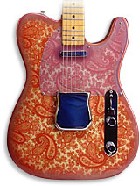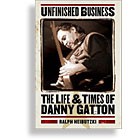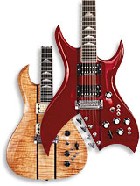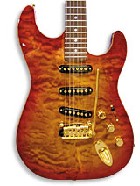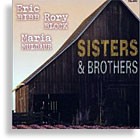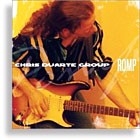Simplicity. You can sum up the success of Fender’s venerable Telecaster model with one word. A cross-cultural phenomenon right down to its name – in a bind, the company essentially named it after the television – its many intuitive features revert to that one word, and players in every genre have used it to create some of history’s most recognized pop music.
Given the simplicity of its design, it’s remarkable that the Telecaster stayed not only viable, but predominant in the 51 years since it was introduced as a single-pickup, slab-bodied piece of innovation. Its profile was nontraditional – a neck that’s bolted on, with frets pounded into it (no laminated fretboard), and a couple of dinky pickups. Nevertheless, the Telecaster has always been ready to boogie.
The Road to the Telecaster
While the Telecaster was not the first solidbody electric guitar, it was groundbreaking in that it succeeded. American guitar manufacturers began playing with the notion of an electric guitar as early as the 1920s; Lloyd Loar was experimenting at Gibson as early as 1924.
Kay (Stromberg-Voisinet) became the first company to put an electric guitar into production, in 1928. It was greeted with much ballyhoo in the trade press and immediately picked up by Chicago radio performers. But interest quickly faded due to technical problems, the Depression, or both.
From the mid 1930s through late ’40s, guitarists’ choices in the electric realm were basically limited to acoustic and archtop instruments with pickups mounted to their tops or in their soundholes. While these certainly furthered the state of music, they were often crude or, in the case of the upscale archtops, prohibitively expensive.
Then came Leo Fender. A radio repairman who, perhaps after seeing Merle Travis play a solidbody Spanish-style electric guitar built by Paul Bigsby, drummed up his own design.
And unlike the unduly sophisticated electric attempts that pre-dated it, Leo’s guitar was meant to be simple; it had to have a solid body (feedback was a huge problem for electric instruments of the day), one pickup, and a bolt-on neck (for easy removal and servicing). Nothing fancy. These factors had as much to do with the fact that Leo intended it to be easy to service/maintain as the fact that Leo’s factory didn’t have the machinery or the money to do anything too sophisticated. This Spanish-style guitar had to be made using the same tools and machines that were making Fender’s lap steels.
Rolling…
So it was that in the winter of 1949-’50, design began in earnest. The shape was created by George Fullerton, who Le hired to help repair amps and lap steels in his shop. Fullerton’s original concept, devised after playing a lap steel-like instrument Leo built to help test a pickup, has been maintained since its inception; a simple shape, with the trademark single cutaway on the treble side.
A prototype made in 1949 looks very much like a Tele of 2002, save for one key feature – the headstock. Though Leo would quickly come to favor six-on-a-side tuners, the proto retained its precedent lap steel headstock, with three Kluson tuners on each side.
With the prototype complete, Leo and Fullerton forged on, and by early 1950 had a guitar ready for distribution by the Radio and Television Equipment Company (RTEC), which distributed Leo’s lap steels and amplifiers. Though Leo wanted the guitar to have two pickups for the sake of tonal versatility, RTEC had a catalog to produce, and wanted the guitar pictured in it.
So it was that RTEC’s Spring catalog carried the Esquire, a Spanish guitar made by Fender Fine Line Instruments and boasting features like “The new adjustable Fender bridge…” Within weeks, the guitar was on also display at the July NAMM show, billed as “Fender’s electric guitar with solid body” or “Spanish guitar,” and with a list price of $139.95.
In a marketing move quarterbacked by Don Randall, RTEC held off on the two-pickup variant, seemingly to test the waters.
Broad… caster
Though response to the Esquire wasn’t tremendous (or even all that good), feedback from players led to the introduction of a steel truss rod for the neck of the guitar (despite Leo’s contention it wasn’t necessary), and the second pickup.
By the end of the Summer of 1950, the guitar was officially introduced to the mass market as the “Broadcaster,” in tribute to the radio – the means by which most of its notes would supposedly be heard. It listed for $169.95.
But not long after, a letter from the Fred Gretsch Manufacturing company politely requested that Fender drop the Broadcaster name because Gretsch had already received a trademark for use on its drums. Not wanting to stir any pots, Fender and RTEC quickly abided, and from February until August of ’51, finishers simply clipped off the “Broadcaster” part of the headstock decals before applying them. Thus was born the “Nocaster,” a name never adopted by Fender but quite well-known amongst vintage guitar enthusiasts.
By April of ’51, a new name had been chosen – and this time trademark researched prior to being introduced. “Telecaster” was selected because of the growing popularity of the television in American culture, and the fact it implied burgeoning technology.
Despite the lukewarm reception to the model, it sold well enough in its first few years.
Then, with the end of the Korean War in sight, demand for fretted instruments took an unexpected jump in early 1953, and Leo, confident that the popularity of the Telecaster and his other instruments would bloom, bought a few acres of land and constructed three new manufacturing buildings. He also developed a sales division for his company and effectively ended his relationship with RTEC.
Sure enough, the solidbody electric guitar took flight, as other companies jumped into the fray, most notably Gibson and Valco.
Wood and Guts
The classic Telecaster image has always been a maple body (with natural finish, of course), maple neck, two pickups, and a pickguard in black. But there have also always been deviations – including the first Esquire that appeared at NAMM, which was finished in an enigmatic black, either to differentiate it from other instruments, or maybe even because its body wasn’t maple, but some other wood that just didn’t look good in blond!
By the Fall of ’54, the black Bakelite pickguard had been replaced with a singe-ply white plastic guard, the brass bridge saddles had been replaced with steel, and the “butterscotch” blond finish changed to an off-white.
In ’55, staggered polepieces were introduced to the bridge pickup and the V-shaped neck became the norm. Also, the dome-top knobs were replaced by lighter-weight knobs with flat tops.
Fender began offering custom colors on its instruments in 1956/’57, though they never proved overly popular – especially to Telecaster buyers/players.
By 1959, the Tele form was approaching its tenth birthday, and other guitars were posing stiff competition. Changes were, perhaps, inevitable.
Family Tree Branches
In 1959, the first significant change was introduced to the Telecaster with the introduction of the Custom, a three-tone sunburst model with binding (arguably “inspired” by Gibson’s top-line guitars), a three-ply pickguard, and a new rosewood fretboard (which all of Fender’s electrics acquired that year). Maple-capped necks remained an option until ’69, when one-piece necks were reintroduced.
But as the guitar boom of the early/mid ’60s blossomed, Fender saw little need to further change the Tele because the model was successfully filling a niche with country, pop, blues, and R&B guitarists. Other Fender instruments did likewise with other genres, and the company as a whole saw fantastic growth.
In fact, because his health wasn’t perfect, and business was so good, Leo decided to sell the company. In a deal finalized in the early days of 1965, media giant CBS became Fender’s parent company. Leo was retained as a consultant, but felt his input wasn’t highly regarded by CBS.
New Era, New Models
Seen as a turning point in the Fender saga, the sale to CBS inarguably marked a change. With corporate ownership came a new way of doing things, and for the most part, the late 1960s and ’70s are not viewed by electric guitar aficionados as the “good times” at Fender.
Quality control suffered as the corporate mind set moved more toward profitability than instrument functionality. There were also some “innovations” that did not stand the test of time, most notably a thick polyester finish that gave the instruments a plastic-looking aesthetic, and Leo’s own “Tilt Neck” adjustment feature (characterized by what became known as the “bullet” truss rod and three-bolt neck).
Nonetheless, the company carried on successfully, and in 1968, the biggest changes yet to hit the Tele was introduced.
Gettin’ Thin
The Telecaster Thinline was developed by Fender R&D man Roger Rossmeisl and body carver Virgilio Simoni to address a sign-of-the-times issue: weight.
Rossmeisl had Simoni carve cavities into a Tele body, and (on the upper bass bout) an f-hole into the top to add flair and show it that it was indeed hollow! Grab hold of one, and the difference is obvious; it weighs about half what a standard Tele does.
Originally, the Thinline’s neck, hardware, and electronics were identical to the standard model, but in late 1971 the model was used to launch Seth Lover’s newly developed 12-cunife, high-output humbucker.
Custom la Vista… Kinda
In ’69, lagging sales meant the end of the Esquire, and by ’72, the Custom (along with a short-lived variant made entirely of rosewood) was deleted from the catalog. Taste trends of the times pretty much spelled the end of custom colors, as natural-finished instruments became the flavor of the day.
The next variation arrived in 1972, when the Custom was redesigned with Lover’s humbucker in the neck position, and a Gibsonesque two-volume/two-tone control knob arrangement with three-way selector in a decidedly Les Paul-type position.
Variations of the Thinline and Custom (called the Deluxe) that used two humbuckers were issued in ’71 and ’73, respectively. The Thinline remained in production through 1979, while the Custom and Deluxe lasted until ’81.
As the ’70s drew to a close, the effects of CBS’ neglect of the highly profitable Fender company began to show. Dealer complaints about quality control grew more common, and sales began to slow as guitarists more readily opted for “old” (a.k.a. pre-CBS) Fender guitars.
Modern Variants
Fender’s first foray into the reissue market started with a Tele; the 1981 Vintage Telecaster was, in theory, a clone of the ’52 model. But given the halfhearted attempt by the corporately shackled company, the first version bore only a slight resemblance to the real deal; glaring errors included an improper body shape and finish color. Fortunately, it was in production only briefly before the inaccuracies were corrected by newly appointed director of marketing, Dan Smith.
Thus began Fender’s participation in what was quickly becoming a significant trend – building new guitars to “old guitar” specifications. And since issuing the first ’52 re-make, Fender has reissued many of the “classics,” including the Nocaster and the Thinline, as well as the short-lived paisley and floral finishes, and the all-rosewood model.
Fender’s standard guitar line now includes dozens of Telecaster variations, including reissues of the ’52 and the ’62 Custom, while the company’s Custom Shop offers its “Time Machine” series ’51 Nocaster and the ’63 Tele in custom colors.
Today, the Telecaster is rightfully revered as the Alpha Male of the solidbody guitar world. It was the first solidbody guitar to be mass-produced and mass-marketed, and its design has left its mark as an icon not only in guitardom, but in the industrial world.
Teleretrospect
Why is the Telecaster such an icon?
– – – – – – – – – – –
It’s the simplicity, and the beauty in that simplicity, that makes the Telecaster such an icon. It’s extemely basic, and everything about it is functional. Plus, it’s unique in its sound and feel.
The first time I played one was in ’63, when I walked into a music store where they had a second-hand one with a rosewood fingerboard. It was beaten up, but quite cheap, so I bought it with visions of James Burton in my mind.
When I plugged it in, it felt so alive – it really does sound like an electric guitar. And every time you play one, it shapes the way you play because of the way it sounds and feels. – Albert Lee, guitar legend
– – – – – – – – – – –
The Tele started as an icon 50 years ago, and has transcended time, through all of the artists who’ve played it, all the wanna-bes, and all the collectors, as the icon of the industry. And we have continuously worked on design and manufacturing processes to keep it there! – Bill Schultz, CEO, Fender
The Fender Telecaster is one of the finest and most enduring of all electric guitar designs. The model is, for all practical purposes, the first Fender solidbody, since it is virtually identical to the early-1950 double-pickup Esquire and the Broadcaster.
The Telecaster has remained virtually identical in its specifications since its introduction. The design is a classic which has withstood the test of time. It was a modernistic guitar when it was introduced and even today the lines flow so smoothly that it is an ageless classic which does not in any way appear out of place.
While feel is a matter of personal preference, most players agree that the Telecaster has as good a feel as any electric guitar on the market. Tone is also a matter of personal, subjective preference, but few would deny that the lead pickup of a vintage Telecaster has one of the truly classic sounds in the electric guitar world. The rhythm pickup of a Telecaster works well but is not, in the opinion of most, what this guitar is all about. In my opinion, the lead pickup sound of the early black-guard Telecasters is as fine as any electric guitar on earth. I personally prefer early Telecasters over any Stratocaster, although I am well aware that there are plenty of folks out there who feel differently. There is no question that a Stratocaster can give more different tones than a Telecaster, but the Telecaster lead pickup is nothing short of phenomenal.
The Telecaster is one of the great archetypes in the electric guitar world, and as the direct descendant of the Broadcaster, may rightfully be considered the first commercially successful solidbody guitar made in quantity by a major manufacturer. This model is without a doubt one of the best designs in the history of musical instruments and industrial design. – George Gruhn, proprietor, Gruhn’s Guitars, and co-author of Gruhn’s Guide to Vintage Guitars
– – – – – – – – – – –
The Telecaster became an icon for two reasons.
First, it was the right product at the right time. Although changes to pop and country music in the early 1950s may not seem so radical compared to music today, they were most certainly radical in comparison to pop music coming out of the ’40s. The guitar really was on the verge of becoming the out-front solo voice in pop music. The Tele wasn’t just radical-looking in comparison to what guitarist’s had been using, it was louder and had a bell-like, cutting quality.
When it first hit the streets in 1950 (as the Esquire/Broadcaster/Nocaster), there was nothing quite like it. For the guitarists who started to use it, it made quite a statement. Hey! Stop, look, and listen – I’m different!
Second, it became an icon because even though it’s not as graceful-looking as the Strat and some other guitars, the sound was right from the beginning. Clear as a bell – a tone that rocks your heart. Pure and honest – if the player hasn’t got it, there’s no hiding the fact. If you can play – well, then everyone’s going to know it, because the Telecaster let’s the player’s own voice come through. The fact that the list of first- couple-of-notes identifiable great Tele players is a long one pays testament to that. – Dan Smith, V.P. of Guitar Research and Development, Fender
– – – – – – – – – – –
The Telecaster is one of the most innovative, versatile and durable guitar designs ever created. When I think of the Tele, the lights come on in the guitarists hall of fame, and the music starts to play; I hear the blazing country-rock licks of Albert Lee, Ray Flacke, Jerry Donahue, and Danny Gatton, Keith Richard’s crunchy rock riffs, the inimitable twang of Roy Buchanan, Andy Summers’ atmospheric guitar work with The Police, the mind-boggling shred of Steve Morse, Steve Cropper’s funky R&B comping, the mellow jazz chords of Ed Bickert and Ted Greene, Jimmy Bryant’s virtuosic country bop, the down-and-dirty Chicago blues of Muddy Waters and the bone-chilling Texas blues of Albert Collins. And that’s the short list. The Telecaster crossed international and stylistic boundaries early on when it was essential to the sound of early Jeff Beck, early Pink Floyd, early Led Zeppelin and late Beatles, and countless others.
The Tele is also pure Americana-from the rolling rockabilly of Paul Burlison and Carl Perkins to the hitmaking guitar hooks of James Burton, Roy Nichols, and Don Rich, and the power chords of Bruce Springsteen. It reaches back as far as 1950s Western swing, with Jimmy Wyble, and is as current as today’s guitar greats like Brent Mason and Jonny Lang.
By any estimate, the Tele will be fueling guitar music into the 21st century and beyond. Long live the Telecaster! – Wolf Marshall, guitar teaching/method guru
– – – – – – – – – – –
Leo Fender had a plainspoken compliment he used to describe something he admired: “It’s built the way it oughta be built.” As the first commercially viable solidbody, the Telecaster revolutionized an industry and defined a whole genre of electric guitars. Because it was the first, and arguably the best, it became the yardstick for measuring everything that followed.
The Telecaster embodies the pure essence of the solidbody electric guitar; the tone, the look, and the character. It’s an icon because of what the electric guitar has come to mean in our lives and our culture. And because as Leo would say, “It’s built the way it oughta be built.” – Richard Smith, author, Fender: The Sound Heard ‘Round The World
– – – – – – – – – – –
The enduring success of the Telecaster seems so obvious: Simple is better. Ever notice how the souped-up versions of the Tele aren’t nearly as popular as the stripped-down original? Same with the Les Paul’s later, jazzier variations. To me, when a guitar (or amp) tries to be an “all-encompassing, please-everybody hybrid,” it fails. In fact, I don’t even like Teles with a middle Strat pickup added; it somehow cheapens its integrity.
Leo Fender’s idea was to make an electric Hawaiian guitar that you could play like a Spanish, fretted guitar, and he did it in about the simplest, most obvious way imaginable. Don’t forget: this is the same mind who decided that the upright bass player should be freed up to do dance steps with the rest of the band, and so invented the Fender Precision bass.
What Leo couldn’t have envisioned was that by placing the volume knob so it was easy to reach, he was supplying the tool for the volume swells that would become one of the building blocks of Roy Buchanan’s style. Or that the location of the upper strap button and the thickness of the Tele’s body would provide Clarence White and Gene Parsons a workbench to invent their “B-bender” to emulate pedal steel licks.
Maybe it’s a “chicken or the egg” question – if the Strat or Les Paul had come first and made its way into country music, would that be the sound we’d associate with Don Rich and James Burton? – but I think the Tele’s tonal range is what carved its way into people’s collective consciousness. When you hear someone chicken pickin’, with that clear, piercing tone that doesn’t quite hurt (or when Johnny Guitar Watson yanks the strings with the treble on 11, and the tone does hurt), you just know it’s got to be a Telecaster.
The same as the first one that rolled off the assembly line, it’s never been improved upon. – Dan Forte, guitar journalist
– – – – – – – – – – –
The Telecaster was the first of a new breed of solid electric guitars with replaceable necks that could be serviced. And when you’re first, that leaves a heck of an impression!
The Telecaster’s penetrating sound defined Fender’s signature guitar tone. In an era of soft, warm guitar tones, the Telecaster offered a penetrating-yet-musical sound that could carry a room. It’s truly a player’s guitar, and not a very forgiving instrument. It responds incredibly to the nuances of one’s technique; as such they are able to define a unique voice or signature style. As a result, players with totally diverse musical backgrounds have chosen the Telecaster to make their mark; Muddy Waters, Roy Buchanan, James Burton, Keith Richards, Jimmy Page, Jeff Beck, and Danny Gatton have all used Telecasters. And when an instrument has such a diverse body of work behind it, it is validated musically and culturally.
It’s hard to deny the Telecaster’s role in helping define contemporary music. – Richard McDonald, V.P., Fender Guitars and Amplifiers
– – – – – – – – – – –
It’s the bicycle of guitars – the most efficient way to get from point A to point B. It has an extremely high style-to-material ratio; just a plank and a stick, some bolts and wires. But it looks cooler than anything. It sounds okay, too, if you like perfect. It’s on a very short list, along with the Coke bottle and the New Holland hay rake (drawn by my father-in-law C.H. Prout about the same time as the Tele) of designs that have endured virtually unchanged for over half a century. I’ve had mine for a third of a century and it’s still my favorite electric, the one I play every day. I like everything about it, from the six-in-line pegs on the skinny head to the brass bridge under the heel of my hand. I’ll bet they were looking at a Tele when they designed the Sputnik. Leo and the guys got it right the first time, didn’t they? – Bill Kirchen, Tele legend
Finish Flights of Fancy
The iconoclastic Telecaster, legendary as it may be, has also been subject to the many whims of its creator as the company experimented with ways to keep the guitar as marketable as possible.
So it is that the Tele has seen its share of design changes, and just as interestingly, finish changes. What started out as a very simple, plainly finished workingman’s tool has, in fact, been subjected to some of Fender’s more dramatic flights of fancy.
With the advent of Fender’s custom color options in 1957, the gate was opened, though few Tele players – being of a traditional mind set – ordered Teles in anything but traditional blond or sunburst. Nonetheless, custom-colored Teles are out there – just not in great numbers.
But beyond sunburst paint and some binding, Fender’s most garish attempts at dressing up (and updating) the Tele came in 1968, with the introduction of the Paisley Red and Blue Flower finishes.
Meant as a direct shot to the hippy/psychedelic “market” of the era, both guitars were standard maple-board instruments with what self-adhesive wallpaper under a polyester clearcoat. Marketed at psychedelic rock music players, it’s no small irony that the paisley guitar became an early-’70s trademark instrument for James Burton, who had moved from playing pop/rockabilly to proto country rock, in addition to his duties as Elvis Presley’s sideman. Lately, the trademark has been carried on by country singer/songwriter/pickin’ hotshot Brad Paisley, who broke into the big time while strumming a ’68 (what other guitar could he possibly have used?!).
An equally esoteric variant was the 1984-only marble finish, a.k.a. the “bowling ball.” A concept conceived and executed as a limited-run; there were three color variants, and only 25 of each color were made (and you got a matching t-shirt free with purchase!).
Probably the rarest-of-rare custom-color Telecasters is a 1968 that was recently scooped up by Rick King, proprietor of Guitar Maniacs, in Seattle. It was reportedly one of a Tele/Strat set made up for a NAMM show that year. After the show, a Fender rep sold them to a dealer in Olathe, Kansas. It sold, and years later resurfaced in a pawn shop in Olathe. King bought it from a man in the area.
Though it has no known “official” name, it has come to be known as a “ghost finish.” Never heard of it? You’re not alone, because like its namesake, it is seldom seen.
Under normal light, the “ghost” Tele looks like any natural-finish instrument from its era. But under black light, the picture changes. Not-so-eerie images emerge on its body, neck, and headstock – flowers, paisleys, and orbs. Obviously hand-painted with a brush, the designs are simple, even a little crude – but prototypical ’60s psychedelic, all the way, baby!
photo: Michael Tamborrino/VG Archive.
This article originally appeared in VG‘s Sep. ’02 issue. All copyrights are by the author and Vintage Guitar magazine. Unauthorized replication or use is strictly prohibited.
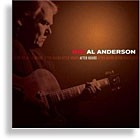

.jpg)
